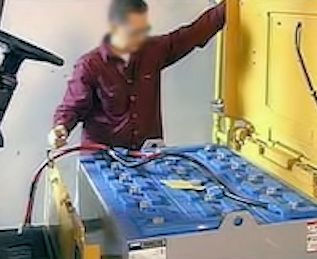Battery Charging Hazards
Forklift battery charging, particularly for electric forklifts, involves specific hazards that need to be managed carefully.

Great care must be given to safety when charging batteries.
Key hazards include:
- Chemical Exposure: Forklift batteries, especially lead-acid batteries, contain sulfuric acid, which can cause burns and respiratory problems if it comes into contact with skin or is inhaled. There's also a risk of battery acid spills.
- Electrical Hazards: Charging batteries involves electrical connections, which can pose risks of electric shock or short-circuits, particularly if the charging equipment is damaged or improperly used.
- Explosive Gases: During charging, lead-acid batteries emit hydrogen gas, which is highly explosive. If this gas accumulates in an enclosed area and comes into contact with a spark or flame, it can cause an explosion.
- Fire Risk: Faulty charging equipment, incorrect charging methods, or damaged batteries can overheat, posing a fire hazard.
- Battery Handling: Batteries are heavy and can cause injury if not handled properly. There's also a risk of dropping a battery, causing damage to the battery and potentially injuring workers.
Real-life Accident
Employee Testing Battery Bank Is Shocked and Burned
At 4:00 p.m. on June 12, 2019, Employee #1 was working at a power plant. The employee was testing a battery bank when electrical energy contacted his head. He received an electric shock and burns to the face and head. The employee was transported to the hospital and admitted for treatment of his injuries.Knowledge Check Choose the best answer for the question.
1-8. What chemical in lead-acid batteries can cause burns and respiratory problems if it comes into contact with skin or is inhaled?
You forgot to answer the question!
